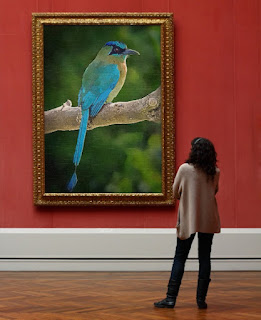Beauty and Design in the Motmot
To stop and think on it for a while, beauty is a word used to describe many things. Sunsets, waterfalls, canyons, the cosmos, certain people, animals, birds, and much more can be called beautiful. That word also describes other things picked up by our senses, things not visual.
Spring is coming in our neck of the woods. I heard a house finch today singing what I call the "Happy to be a birdie" song, which is beautiful. Who would have thought that beauty could make me sad? It is because my beloved wife is not here to share it with me.
 |
| Motmot photo by Andy Morffew at Pxhere, modified at PhotoFunia |
Scientists have found that there certain barbs fall off, which at first may feed into the "poor design, therefore evolution" arguments. In fact, even secular scientists admit that these barbs fall off as the result of a predetermined plan; there is beauty in design.
Materialists believe that only atoms, molecules...physical things exist, so there is no God. No soul, either. Such a worldview is ridiculous and self-refuting, because it also rules out logic, laws of nature, science, love — and beauty. Those things are not material, but we all use them. (It makes things worse for them that beauty is subjective. I see beauty in crows. My wife did not.) To be a consistent materialist would make for a dismal existence indeed.
As I have said elsewhere, we are living in a wrecked world. We cannot imagine what it was like before the Genesis Flood, but it must have been far better than it is now. God designed it so that even in its current state, the world still has beauty. Not only are things beautiful for our sakes because of the beneficent Creator, but beauty itself is a part of his nature!
Because ultimate beauty belongs to God, it’s not surprising that His creation—even in its fallen condition—exhibits many examples of beauty, one of which is a bird called the turquoise-browed motmot (Eumomota superciliosa). This Neotropical forest bird’s plumage combines emerald green, cyan-to-indigo blue, and brownish russet, and the wings have a black outline when outspread. It has a decurved (curved downward) bill that it uses to snag insects or pick fruit, and it has conspicuous, turquoise-colored eyebrows. But the motmot’s real claim to fame is its two extra-long racket-tail feathers that are used for balance and wagtail signaling.
To read it all, fly on over to "Motmot's Beauty Displays God’s Gracious Design." Now watch the beautiful Alice Sara Ott play on a beautiful piano a beautiful piece. Shall I describe how she plays it? Nah.